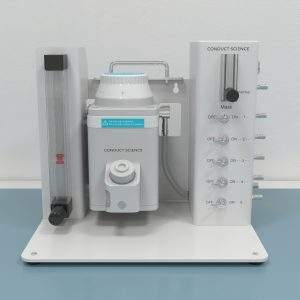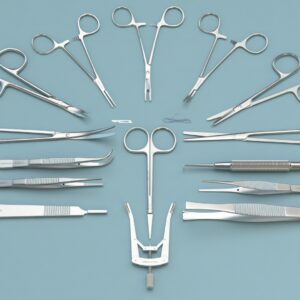These parameters are measured for both the control group and for the scopolamine group to make comparisons regarding how the cognitive function of the subjects is affected.
$2,290.00
Pigs play a crucial role in TBI research due to their similarities to humans, and the 8-arm radial maze is widely employed for studying learning and memory. Elmore et al. (2012) first described its use in piglets as young as two weeks old. The Pig T Maze is constructed from clear plastic in a plus-shaped configuration (essentially a double T-maze) placed atop textured black rubber mats. It features a removable barrier to convert it into a standard T-maze and allows alternating the start arm during testing. The acrylic walls are designed to accommodate two-week-old piglets for tasks involving novel place and directional spatial learning in the T maze. Your order includes four PVC bowls.

MazeEngineers empowers preclinical neuroscience research with meticulously designed, customizable behavioral apparatuses. From manual classic mazes to fully automated smart systems, we provide the tools scientists need to capture high-quality, reproducible data for studies on learning, memory, anxiety, and depression.

bool(false)


Features |
Arm Length: 91cm |
Arm Width: 30cm |
Wall height: 50cm |
4 PVC bowls included |

The porcine brain serves as a valuable experimental model for testing drugs and studying behavioral changes due to its anatomical and developmental similarities to human infants, contrasting with laboratory rodents. Piglets are particularly suited for experiments due to their precocial nature, ease of weaning, and reduced separation anxiety from mothers, facilitating critical investigations into neurodevelopment and cognition. This enables assessment of early-life insults like infections or nutritional deficiencies (Elmore et al., 2012).
Unlike the rodent T maze, the pig T maze features a plus-shaped design that supports cognitive tasks assessing ‘place’ and ‘direction’ learning. This design allows for two start arms (north or south) and two reward arms (east or west), encouraging the use of allocentric mechanisms relying on visual cues rather than egocentric methods. This setup aids in more precise measurements of memory and learning impairments, crucial for evaluating hippocampal lesions’ effects (Elmore et al., 2012; Jarrard et al., 1995).
Moreover, the T maze facilitates assessment of drugs and chemicals affecting learning and memory mechanisms, such as scopolamine, to investigate environmental impacts on neonatal piglet brain neurodevelopment. The hippocampus, sensitive to experimental manipulations and dietary changes, allows for diverse variables to be measured using modified T maze tasks tailored to hippocampal dependence. Incorporating a start box minimizes pre-experiment handling, optimizing behavioral task conditions (Elmore et al., 2012).
The Pig T-maze is a unique double T-maze, featuring a clear plastic plus-shaped design positioned over textured black rubber mats. It includes a removable barrier to configure into a standard T-maze, allowing for two start arms (north and south) and two reward arms (east and west). This setup encourages subjects to employ allocentric mechanisms rather than egocentric ones to solve tasks. Each arm measures 91 cm x 30 cm with walls standing 50 cm tall.
For visual guidance, colored posters within piglets’ dichromatic vision spectrum are placed as external cues, affixed to opaque curtains surrounding the testing arena. Additionally, stationary PVC bowls are positioned at the ends of the east and west reward arms (Elmore et al., 2012).
Pig neonates undergo a two-week feeding regimen starting at two days old before behavioral testing commences. They receive hourly feedings for 18 hours with a 6-hour fasting period to standardize conditions. Each PVC bowl used during testing contains approximately 3 ml of chocolate milk to prevent olfactory cues from guiding subjects to the correct arm. Both bowls feature opaque, perforated lids, with only one accessible to subjects, ensuring elimination of visual cues and reinforcing task accuracy. Chocolate milk is strictly reserved for experimental sessions to maintain high motivation levels.
To monitor subject movements, a video camera is positioned overhead within the arena, allowing real-time tracking using Noldus Ethovision XT software (Elmore et al., 2012).
Animals undergo habituation to handling through daily interactions involving cleaning and feeding by experimenters. Furthermore, subjects are acclimated to the maze environment through daily 5-minute exploratory sessions over the course of a week prior to behavioral testing.
Behavioral testing commences 14 days after the experiment’s initiation, conducted daily following a 6-hour overnight fasting period. Subjects undergo 10 trials per day over 13 days: the first 9 days focus on the acquisition phase where they learn to locate a milk reward using extra-maze visual cues with an 80% correct decision criterion. This is followed by a reversal phase where a previously incorrect arm becomes the correct one.
Each trial begins with subjects placed in either the north or south start arm based on pseudorandom selection. An experimenter removes the clear removable barrier to release subjects into the maze from a start box, reducing stress from physical transportation. Subjects have 60 seconds to choose between the east or west arm to receive a chocolate milk reward upon correct selection. After consuming the reward, subjects return to the start box for the next trial.
During the first two days of the acquisition phase, subjects may retrace their steps to find the correct arm if incorrect. However, retracing is prohibited from the third day onward. Milk rewards are refreshed while mimicking replacements for incorrect bowls in the start box. The maze is wiped clean with 70% ethanol if milk drips, urination, or defecation occur.
In this experimental phase, subjects are acquired, housed, and raised as previously described. The divergence occurs during behavioral testing, where piglets receive either i.m. injections of scopolamine or PBS 15-30 minutes before daily testing commences. The injection site is alternated to prevent discomfort. This phase aims to evaluate the impact of scopolamine injections on subjects’ learning abilities.
The following parameters are recorded to carry out data analyses:
These parameters are measured for both the control group and for the scopolamine group to make comparisons regarding how the cognitive function of the subjects is affected.
The plus-shaped configuration of the T-maze facilitates compelling subjects to select between two reward arms, enabling the application of allocentric learning mechanisms for improved assessment of hippocampal lesions. Moreover, the use of a start box minimizes non-compliance and reduces excessive handling immediately before experiments begin. Odor cues are promptly mitigated by cleaning the maze. Additionally, employing piglets offers several advantages due to their neuroanatomical resemblance to human infants. Piglets are also straightforward to wean and manage.
Elmore, M. R., Dilger, R. N. & Johnson, R. W. (2012). Place and direction learning in a spatial T-maze task by neonatal piglets. Animal Cognition, 15 (4), 667-676.
Jarrard, L. E. (1995). What does the hippocampus really do? Behav Brain Res 71:1–10
There are no questions yet. Be the first to ask a question about this product.